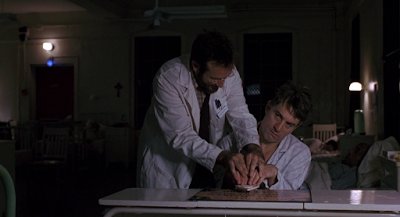Synopsis
The movie is an adaptation of Oliver Sack's book (1973) based on a true story. He was a British neurologist who discovered the effects of L-dopa and administered these drugs to catatonic patients who survived the 1917-1928 epidemic of encephalitis lethargica.
Leonard's Character (and Other Patients)
The experience of suffering was quite graphic with powerful scenes, conveying the pain that these patients went through. It showed the deterioration of the patients' health, such as being unable to do basic things (like to read or to talk) and having no control over their own body due to their condition.
Seeing the transition of how the patients were prior to the L-dopa medication and during the time of their medication itself created a sense of intrigue among the audience towards the patients, and caused us to empathise with the patients even more -- especially after seeing how much it affected their loved ones; the ones who stayed. During the medication, the patients' personalities were brought to the surface and engaged the audience even more. This made it compelling to watch their interactions with each other -- it humanised them, not just portraying them as catatonic patients who were 'asleep'. It was able to grasp the audience's attention as it was fascinating to see them finally 'come to life' and 'awaken'; to see their true selves. This linked the audience to the characters even more and formed more of a connection.
Moreover, the treatment of the patients was shown through a realistic light - that not every doctor treats their patients nicely. They just wanted to be treated like normal human beings, but instead, are viewed as sick and unable to do things on their own. Their label as patients had stuck to them that even the doctors themselves treat them as such, rather than viewing them as capable humans (especially during medication) who are willing to try and get better. These are the simple things that we take for granted, and definitely the take away message from this film.
Emotional Element
The movie touched the audience's hearts from arousing a range of emotions. The movie was able to build a connection with the characters at first, as we see how they are on a day to day basis. How difficult and challenging it is for their remaining loved ones who stayed to take care of them, and how much they hold deeply to every bit of hope that they have any chance of them getting better eventually. While for others, their families and spouses have left them - again, a realistic depiction as it happens in everyday life as well. It is such a tragic thing to happen to them as they have lost hope and the patients awaken to them not by their side anymore.
The connection we have with the characters toy with our emotions as we feel happy for them when they eventually got better. There were comedic reliefs that helped lifted up the spirit of the movie at times, as it would have been too intense to watch. This was more towards during the time of their medication, when everyone was better, which elevated the emotions felt.
However, towards the end when the effects backfired and the patients' condition were deteriorating, the mood plummeted again because of how close and connected we feel to the characters. We cried when they cried and laughed when they laughed. The movie brought out a fluctuation of reactions, making the audience feel as though they are on the journey with the characters, too.

Dr. Sayer's Character
His character is layered and complex, actually being displayed as a real person and not just one dimensional. As the movie goes along, we learn more about Dr Sayer, such as him not being a people-person, and it could be seen how uncomfortable he is with human interactions. But eventually, it is seen that the patients had an effect on his outlook on life, causing him to eventually try to be around people. It also shows his journey of how the actions of someone can have a ripple effect.



No comments:
Post a Comment